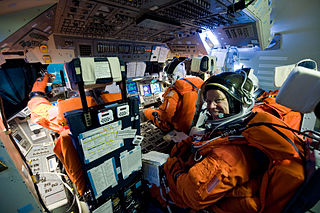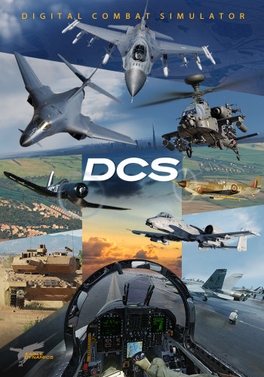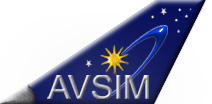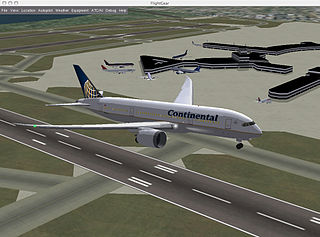
A simulation is an imitative representation of a process or system that could exist in the real world. In this broad sense, simulation can often be used interchangeably with model. Sometimes a clear distinction between the two terms is made, in which simulations require the use of models; the model represents the key characteristics or behaviors of the selected system or process, whereas the simulation represents the evolution of the model over time. Another way to distinguish between the terms is to define simulation as experimentation with the help of a model. This definition includes time-independent simulations. Often, computers are used to execute the simulation.

Air traffic control (ATC) is a service provided by ground-based air traffic controllers (people) who direct aircraft on the ground and through a given section of controlled airspace, and can provide advisory services to aircraft in non-controlled airspace. The primary purpose of ATC worldwide is to prevent collisions, organise and expedite the flow of traffic in the air, and provide information and other support for pilots.

A flight simulator is a device that artificially re-creates aircraft flight and the environment in which it flies, for pilot training, design, or other purposes. It includes replicating the equations that govern how aircraft fly, how they react to applications of flight controls, the effects of other aircraft systems, and how the aircraft reacts to external factors such as air density, turbulence, wind shear, cloud, precipitation, etc. Flight simulation is used for a variety of reasons, including flight training, the design and development of the aircraft itself, and research into aircraft characteristics and control handling qualities.

Microsoft Flight Simulator is a series of flight simulator programs for MS-DOS, Classic Mac OS and Microsoft Windows operating systems. It was an early product in the Microsoft application portfolio and differed significantly from Microsoft's other software, which was largely business-oriented. As of November 2022, Microsoft Flight Simulator is the longest-running software product line for Microsoft, predating Windows by three years. Microsoft Flight Simulator is one of the longest-running PC video game series of all time.
X-Plane is a flight simulation software initially launched by Laminar Research in 1995. Commercial desktop versions are sold for macOS, Windows, and Linux. In addition, Laminar Research also distributes FAA-certified versions for professional use. A mobile version has been available for Android, iOS, and webOS since 2009 as well.
A virtual airline (VA) is a dedicated hobby organization that uses flight simulation to model the operations of an airline. Virtual airlines generally have a presence on the Internet, similar to a real airline. Many hundreds of virtual airlines of significance are currently active, with tens of thousands of participants involved at any one time.

Teleprocessing Network Simulator (TPNS) is an IBM licensed program, first released in 1976 as a test automation tool to simulate the end-user activity of network terminal(s) to a mainframe computer system, for functional testing, regression testing, system testing, capacity management, benchmarking and stress testing.

Microsoft Flight Simulator X is a 2006 flight simulation video game originally developed by Aces Game Studio and published by Microsoft Game Studios for Microsoft Windows. It is the sequel to Microsoft Flight Simulator 2004 and the tenth installment of the Microsoft Flight Simulator series, which was first released in 1982. It is built on an upgraded graphics rendering engine, showcasing DirectX 10 features in Windows Vista and was marketed by Microsoft as the most important technological milestone in the series at the time. FSX is the first version in the series to be released on DVD media.

Thai Airways International Flight 311 (TG311/THA311) was a flight from Bangkok, Thailand's Don Mueang International Airport to Kathmandu, Nepal's Tribhuvan International Airport. On Friday, 31 July 1992, an Airbus A310-304 on the route, registration HS-TID, crashed on approach to Kathmandu. At 07:00:26 UTC, the aircraft crashed into the side of a mountain 37 kilometres (23 mi) north of Kathmandu at an altitude of 11,500 ft (3,505 m) and a ground speed of 300 knots, killing all 113 passengers and crew members on board. This was both the first hull loss and the first fatal accident involving the Airbus A310.

Shuttle Mission Simulator (SMS) was an umbrella term for three separate simulators for training Space Shuttle crews at the Johnson Space Center (JSC). The simulators were the MBS, the FBS, and the GNS.

TRACON is a series of game software programs that simulate an air traffic control environment on a personal computer. The games were originally sold by Texas-based Wesson International as an offshoot to their line of professional air traffic control simulation products. TRACON and RAPCON were released in 1989, and TRACON II was released in 1990. Wesson was merged into Adacel in 2001.

Dogfight is a demonstration program initially written by Gary Tarolli at Silicon Graphics, Inc in the summer of 1983. It represents landmarks in two key areas of Internet development: games and multicasting, and notable advancement in creating rendered virtual environments.

Digital Combat Simulator, or DCS, is a combat flight simulation game developed primarily by Eagle Dynamics and The Fighter Collection.

AVSIM is a nonprofit flight simulation social networking service that focuses on Microsoft Flight Simulator, Prepar3D, and X-Plane. It features a community forum, file library, and product reviews. The website is maintained by a group of volunteers. Bandwidth and equipment is paid for by donations and advertising. It is one of the world's largest flight simulation websites and provides users access to information and add-ons for the flight simulator series of games. On May 12, 2009, the website was attacked by a hacker which resulted in a catastrophic loss of data. AVSIM was able to fully recover from the hack with the help of IT support from around the world.
Human-in-the-loop (HITL) is used in multiple contexts. It can be defined as a model requiring human interaction. HITL is associated with modeling and simulation (M&S) in the live, virtual, and constructive taxonomy. HITL along with the related human-on-the-loop are also used in relation to lethal autonomous weapons. Further, HITL is used in the context of machine learning.

A flight simulation video game refers to the simulation of various aspects of flight or the flight environment for purposes other than flight training or aircraft development. A significant community of simulation enthusiasts is supported by several commercial software packages, as well as commercial and homebuilt hardware. Open-source software that is used by the aerospace industry like FlightGear, whose flight dynamics engine (JSBSim) is used in a 2015 NASA benchmark to judge new simulation code to space industry standards, is also available for private use. A popular type of flight simulators video games are combat flight simulators, which simulate combat air operations from the pilot and crew's point of view. Combat flight simulation titles are more numerous than civilian flight simulators due to variety of subject matter available and market demand.
Remote and virtual tower (RVT) is a modern concept where the air traffic service (ATS) at an airport is performed somewhere other than in the local control tower. Although it was initially developed for airports with low traffic levels, in 2021 it was implemented at a major international airport, London City Airport.

International Virtual Aviation Organisation VZW (IVAO) is a non-profit association which operates a free-of-charge online flight-simulation network. Following free registration users can connect to the IVAO Network (IVAN) either as a virtual air traffic controller or as a virtual pilot and engage and interact with each other in a massively multiplayer environment utilising real-world aviation procedures, phraseology and techniques.

Northwest Airlines Flight 188 was a regularly scheduled flight from San Diego, California, to Minneapolis/St. Paul, Minnesota, on October 21, 2009, which landed over one hour late in Minneapolis/St Paul after overshooting its destination by more than 150 miles (240 km) because of pilot error. As a result of the incident, the Federal Aviation Administration (FAA) revoked the pilot certificates of the involved pilots and the National Transportation Safety Board (NTSB) issued recommendations for changes to air traffic control procedures and the rules for cockpit crew. The incident also caused American lawmakers to move to prevent pilots on U.S. airliners from using personal electronic devices while taxiing or flying. In 2013, changes to flight deck automation were suggested, and prototype designs that could mitigate errors leading to similar incidents were described.

Microsoft Flight Simulator is a flight simulation video game developed by Asobo Studio and published by Xbox Game Studios. It is an entry in the Microsoft Flight Simulator series which began in 1982, and was preceded by Microsoft Flight Simulator X in 2006. The game is a return of the series after 14 years, with development beginning six years prior to its release. It was released on August 18, 2020, for Windows, with a virtual reality (VR) version released in December of the same year as part of the free Sim 2 update. Microsoft Flight Simulator is the first game in the series to see a VR and console release, with it being released on the Xbox Series X and Series S on July 27, 2021.























